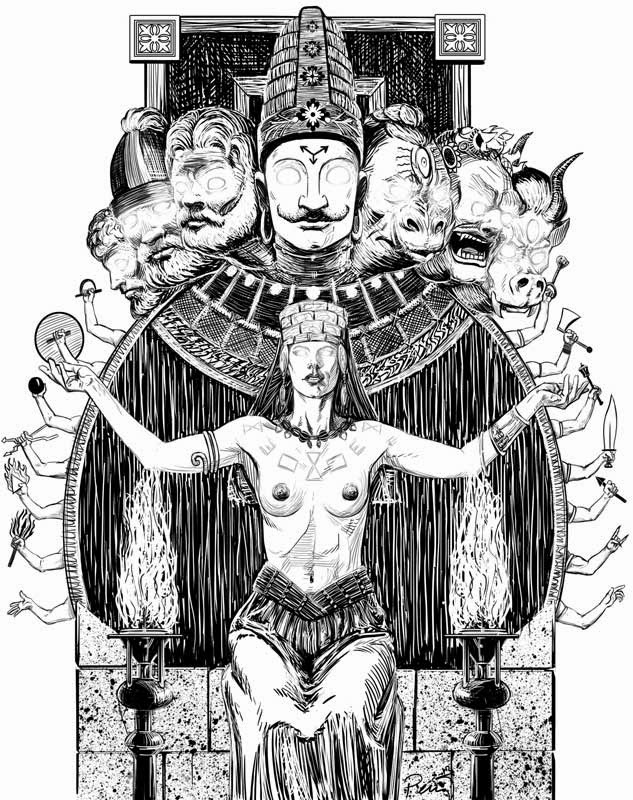Jun 24, 2013

Although we went a different direction in the final piece, this is the original art direction:
Story
The ambitious High Priestess of the Green Goddess is performing a magical ritual to gain the support of the god Arkat, hoping the seven headed Dark Emperor will aid her in her schemes to unite the city-states of the region under her domination.Temple Interior
The temple is dark and cavernous. Frescoes depicting gods, demons, and the Underworld can barely be seen. Think something like this:http://www.imagesofceylon.com/ruins/r155-full.jpg The temple interior is smoky with incense.
Seven-Headed God
At the center of the picture is a shrine to a seven-headed and fourteen-armed god, Arkat, the Dark Emperor, a most important and contradictory hero-god-demon. Arkat is trampling/dismembering/murdering/whatever the demon Gbaji. The god might be depicted as stone statue, bronze statue, or as a painting or relief.
Bronze statue example:http://www.exoticindiaart.com/details/sculptures/xe09.jpg
Stone relief example:http://upload.wikimedia.org/wikipedia/commons/0/08/Shiva_Tripurantaka.jpg
Painting example:http://www.kheper.net/topics/Tantra/de88.jpg
I think a bronze statue would be the most dramatic, but I trust your judgment of composition. 😀
The god has seven-heads and fourteen-arms. Each is head is different and associated with a right and left arm which carries the symbols of that aspect. The whole things should have a Hindu-Buddhist feel to it, with some particularly Gloranthan features.
Peacemaker: This head represents Arkat as the bringer of peace between species, commemorating the friendships he forged between humans, elves, and trolls.
Head:
Right Arm: hand is outstretched with open palm forward in a gesture of fearless peace.
Left Arm: hand is held out, with palm uppermost and the fingers pointing downwards.
Chaosbane: This head represents Arkat as the destroyer of Chaos in all its forms.
Head: I imagine it based on Vajrapani (the patron Bodhisatva of the Shaolin Temple – anger and power personified):http://upload.wikimedia.org/wikipedia/commons/b/b2/Varjapani_magao_caves.jpg
Right Arm: Carries a long leaf shaped sword.
Left Arm: Carries a thunderbolt (btw, for reference thunderbolts were depicted in ancient art likehttp://richaje.livejournal.com/9538.html orhttp://images.travelpod.com/users/nateandglenn/1.1286634558.mighty-zeus-with-thunderbolt-throwing-action.jpg orhttp://www.ancientgreece.co.uk/gods/explore/images/objects/zeus.jpg – and not as the modern zig-zag).
Savior: This head represents Arkat as the bringer of Truth against the lies of Gbaji.
Head: A heroic bearded figure like this Greco-Indian depiction of Vajrapani-Heracles:http://upload.wikimedia.org/wikipedia/commons/a/a4/TheBuddhaAndVajrapaniGandhara2ndCentury.jpg (the figure on the right side), with rams horns.
Right Arm: Carries a small bronze age axe.
Left Arm: Carries a small round shield.
Great Arkat: Ths head represents Arkat as the founder of a great kingdom after the defeat of Gbaji.
Head: The head is meditative and tranquil with a high crown likehttp://www.exoticindia.com/brass/shiva_manifested_as_bhairava_zj75.jpg On his forehead is the following symbol of three arrows joined at the center and forming a “Y”: Around its neck it wears a torc or neck-ring.
Right Arm: Carries a serpent-headed sceptre.
Left Arm: Carries a rod and ring symbol:http://upload.wikimedia.org/wikipedia/commons/9/98/Lilith_Periodo_de_Isin_Larsa_y_Babilonia.JPG (the items carried by the Lilith figure in this relief).
Liberator: This head represents Arkat as a historical figure, a Western sorcerer-warrior who liberated the land from Gbaji.
Head: Helmeted like a Parthian cataphract, with a mustache.http://unitedcats.files.wordpress.com/2008/10/parthian_cataphract.gif
Right Arm:Carries a spear.
Left Arm: Carries a Law Rune (a triangle) wreathed in flames.
Destroyer: This head represents Arkat as a monstrous incarnation of Destruction.
Head: The head is that of a Gloranthan dark troll (see attached picture Zorak Zorani). The demonic head is tusked and has a third eye as in the attached picture.
Right Arm: Carries a flanged mace.
Left Arm: Carries a black ball (symbolizing darkness)
Deceiver: This head represents Arkat as the Demon Gbaji.http://multipletext.com/2010/images/2-5_tangka_4.jpg
Head: Identical to the demon being crushed underfoot!
Right Arm: Taloned and making some strange occult symbol with its fingers.
Left Arm: Taloned and carrying a flaming spear.
The Demon Gbaji
The Seven-Headed Arkat is trampling/dismembering the Chaos Demon Gbaji, who should look like a wrathful Tibetan demon:http://multipletext.com/2010/images/2-5_tangka_4.jpg. I imagine the trampling to look like this:http://www.tcoletribalrugs.com/resources/Kanchipuram/kanchi2.jpg
Whew! All that just for the shrine! Around the shrine is the altar, the Queen, and the sorcerous-priests of Arkat.
Altar
The altar is a basic horned altar (http://emp.byui.edu/SATTERFIELDB/Ancient%20Israel/Pictures/Beer%20Sheba%20Altar%201.jpg), with smoke burning from it. The queen has jsut offered a sacrifice to Arkat – maybe just incense and herbs, maybe a sheep or other animal. Your call.
High Priestess
Leading the sacrifice is Alangellia, High Priestess of the Great Green Lady, the goddess of sexual love and fertility (think Inkarne or Inanna). Beautiful, sensual, and dangerous, she wears the Golden Necklace of Life from her goddess; while she wears it, no man can resist her. Key words – beautiful, sensual, and dangerous. She is tattooed with the runes of Earth, Fertility, and Mastery.
I imagine she looks like a cross between the astarte.jpg and the IMG_8072.jpg. She wears an ornate flounced skirt, but is bare-breasted. She wears a magnificent golden necklace (likehttp://upload.wikimedia.org/wikipedia/commons/c/c4/Franz_von_Stuck_Salome_II.jpg?uselang=de but in gold or http://commons.wikimedia.org/wiki/File:Golden_necklace_from_F%C3%A4rjestaden,_Sweden.jpg?uselang=de orhttp://commons.wikimedia.org/wiki/File:Antalya_Museum_-_Elmali_Goldschmuck.jpg?uselang=de). She wears a golden crown or headdress as in IMG_8072.jpg.
This was originally posted on Google+…, the original can now be found on Tapatalk:
Related Pages
- Art of the Guide to Glorantha
- FAQ about the Guide to Glorantha
- Guide Art Direction – Aldryami
- Guide Art Direction – Mostali
- Guide Art Direction – Orlanthi (2013)
- Guide Art Direction – Pelorian (2013)
- Guide Art Direction – Hsunchen (2013)
- Guide Interview – Greg Stafford (2012)
- Guide Interview – Jeff Richard
- Guide Interview – Mark Rein-Hagen
- Guide Interview – Rob Heinsoo
- Guide Overview – Fonrit
- Guide Overview – Kralorela
- Guide Overview – Praxian
- Guide Overview – The West
- Guide to the Guide to Glorantha
Page Last updated: 2022-09-15 16:18:41
